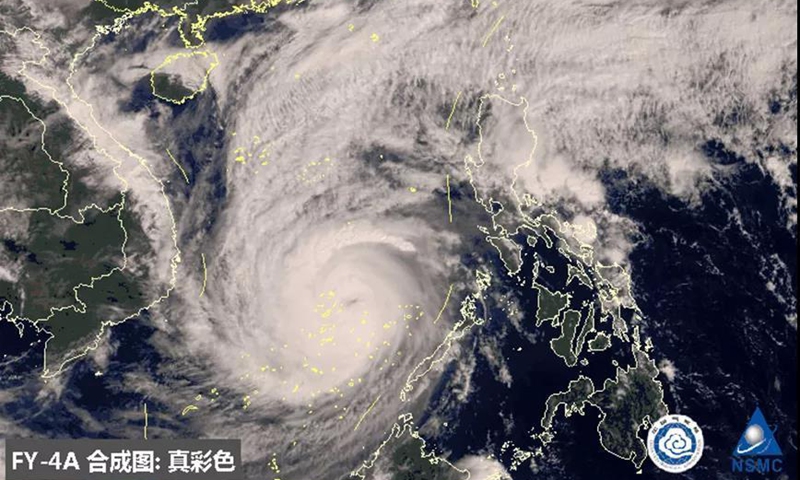
Photo: screenshot from National Meteorological Center
The National Marine Forecasting Center issued an orange warning on Sunday as sea conditions in the South China Sea were deemed serious as a result of the joint impact of super typhoon Rai - the strongest typhoon to affect the Nansha Islands since 1949 - and cold air, the Global Times learnt from China's Ministry of Natural Resources.
An alert for the waves and a blue alert for the storm surge in the coastal waters of eastern and southern Hainan were issued, according to the ministry. Waves with heights of four to six meters were reported in the southern part of the waters of South China Sea.
China launched a level-4 emergency response for possible meteorological disasters brought by the typhoon on Saturday afternoon. But analysts believe Rai is less likely to make landfall in South China's Hainan Province.
On 2:00 pm Sunday, the center of typhoon Rai, the 22nd this year, was located in the southern waters of South China Sea with a maximum strength of Force 15.
According to forecasts from the National Meteorological Center, Rai is expected to move at a speed of 15-20 kilometers per hour northwest, gradually approaching the sea off the southeast of Hainan island.
Rai was tracking westward across the South China Sea as of late Friday after transiting the central Philippines from Thursday to Friday.
From Sunday evening to Monday, the western part of the South China Sea is expected to have six to nine meters of huge storms. Coastal waters off eastern and southern Hainan and coastal waters off South China's Guangdong Province are expected to see huge waves.
After entering the South China Sea, the wind speed near the center of Rai strengthened to 52 meters per second, which is higher than the maximum wind speed of 42 meters per second of the 6th typhoon of this year, Typhoon In-Fa. Rai is the strongest typhoon to affect Nansha Islands since 1949, the Xinhua News Agency reported.
It is expected to move northwestward at 25 to 30 kilometers per hour, with little change in intensity.
The coastal areas of Hainan, Guangdong, Fujian provinces, South China's Guangxi Zhuang Autonomous Region, and other regions will see wind and rain from Sunday to Monday. The rain brought by Rai will help alleviate the drought in those areas, Xinhua reported.
Three ports in the city of Haikou, Hainan will cease operations around the early morning of Monday.
Local authorities in coastal regions have been requested to make emergency preparations against storm surges, China's Ministry of Natural Resources said. All sea-related production units must take effective measures to organize fishing boats and breeding farms to carry out defensive work, the ministry said. It also called for preparations to be strengthened against moisture in coastal fishery and aquaculture facilities and fishing port facilities.
Xu Yinglong, chief forecaster of the National Meteorological Center, was quoted by Xinhua saying that "Rai is expected to gradually approach the eastern sea of Hainan Island, and it is less likely to land on Hainan."
Xu said that during Rai's northward journey, the sea surface temperature in its path gradually decreased, and it will tend to weaken under the joint influence of cold air and strong environmental wind vertical shear, so it is expected to gradually weaken and dissipate over the northern part of the South China Sea on the night of Tuesday.
But whether it makes landfall or not, the winds brought by Rai cannot be ignored, Xu warned. "Due to heavy winds and waves in most of the South China Sea and the waters around Xisha, Zhongsha and Nansha islands in the next two days, special attention should be paid on maritime operations, navigation and the safety of fishermen," Xu said.
It is still uncertain about how far Rai will travel as it moves northward, how long it will last, and exactly where it will weaken and dissipate, Xinhua said.




